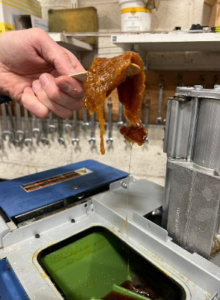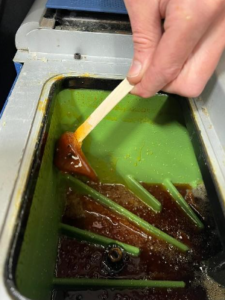As any experienced user of commercial hot melt adhesives knows, it’s important to switch the tank off when you’re not using it. There are several reasons for this, but the most important one is safety.
Hot melt adhesives are molten when in use and can remain hot for some time after being switched off. If the equipment is left on, there is a risk of the adhesive solidifying in the nozzle and becoming a fire hazard. Degraded adhesive, or char, is one of the main causes of a wide range of hot melt equipment faults, from reduced efficiency and low flow rate to abrupt failure.
Clean On The Outside, Filthy On The Inside
However, baked-on adhesive doesn’t just cause problems in the dispenser nozzles, pipes, and the outside of the tank. As these images from a recent project show, leaving hot melt equipment running unnecessarily can also play havoc within the tank itself.


The customer bought this machine to us after it completely stopped working, and they suspected a mechanical fault. On the outside, the machine was spotless, and the customer had meticulously observed a cleaning and visual inspection routine for the exterior components. However, once we opened the hot melt tank itself, we found it completely clogged with baked on glue at least half an inch thick. This ‘skin’ had built up over time from the machine being left on while not in use. When this happens, even for a few minutes, any residual glue in the tank ‘cooks’, causing a build-up of degraded adhesive that is very difficult to shift, and that will eventually impede the operation of your machine.
In addition, leaving the tank on when not actively dispensing glue can also shorten its lifespan, as the constant heating (often up to 150°C in order to melt the glue) and cooling will put strain on your components. So, for both safety and efficiency reasons, it’s always best to switch your hot melt adhesive tank off when you’re finished with it.
Alternatively, you can also put the tank into ‘Standby mode’ where it will remain on but with a considerably lower tank temperature, preventing the glue from continuing to cook and degrade. It should be noted to operators that if this is done, it will take a short period of time to re heat the glue back up to operating temperature, to then be used as normal.
Cleaning, Inspection, And Maintenance
The best way to avoid the build-up of char in your tank is to regularly strip back your machine and clean out any old glue before it becomes a problem. This can be messy, time-consuming, and difficult to do in house, so most businesses find it cost-effective to outsource this task to a professional cleaning and maintenance company, such as ourselves. We can remove any adhesive build-up and address mechanical problems at regular intervals so that your equipment runs at full working capacity.
If you’d like to find out more or to request a quote, please call 01480 772067 today.
